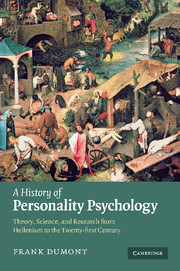 A History of Personality Psychology
A History of Personality Psychology Book contents
- Frontmatter
- Contents
- List of tables and figures
- Preface
- 1 Historical precursors of personality theory
- 2 From illness to wellness models of human nature
- 3 Developmental perspectives on personality: from youth-based to life-span models
- 4 The biology of personality
- 5 Trait theories and the psychology of individual differences
- 6 The puzzle of the self
- 7 Culture and personality
- 8 Gendered personality
- 9 Emotions and reasoning: a definition of the Human
- 10 Taking the measure of the Human: benefits and inherent limitations of personality measures
- 11 Can personality change? The possibilities of psychotherapeutics
- 12 The disordered personality: evolution of nosological systems
- 13 Eight appendices: at the margins of personality psychology
- References
- Author index
- Subject index
5 - Trait theories and the psychology of individual differences
Published online by Cambridge University Press: 03 May 2010
- Frontmatter
- Contents
- List of tables and figures
- Preface
- 1 Historical precursors of personality theory
- 2 From illness to wellness models of human nature
- 3 Developmental perspectives on personality: from youth-based to life-span models
- 4 The biology of personality
- 5 Trait theories and the psychology of individual differences
- 6 The puzzle of the self
- 7 Culture and personality
- 8 Gendered personality
- 9 Emotions and reasoning: a definition of the Human
- 10 Taking the measure of the Human: benefits and inherent limitations of personality measures
- 11 Can personality change? The possibilities of psychotherapeutics
- 12 The disordered personality: evolution of nosological systems
- 13 Eight appendices: at the margins of personality psychology
- References
- Author index
- Subject index
Summary
Why is the breed of lions violent, sullen or furious? Why are foxes sly, clever, astute? What makes the deer so swift, so timorous? Why are all such traits and others consistent throughout all the generations? It must be that in every stock and seed the power of mind parallels growth of body …
Lucretius (55 bce)Traits as constructs
Traits, we must note from the outset, are not per se observables. Nor are they real entities. You will never be able to place them under a microscope. They are descriptive schemas that are the product of human reason and imagination. They serve a heuristic purpose, as do all other constructs about the world in which we live: namely, they give a conceptual order to our world and make it more comprehensible than it would be without them. That Allport ([1937] 1961), for example, stipulates that traits – or personality for that matter – have neuropsychic referents does not turn them into things (reify them so to speak). Freud, for example, spoke of the Oedipal complex, “penis envy,” and numerous other “dynamic” elements of the human psyche, affirming all the while that these descriptors of human psychical states and behavior could be mapped in principle to brain structures. Clearly, conceptualizing a psychical entity or a “complex,” and then establishing a semantic explanatory link to a neurologic substrate, does not make the entity real or any less a hypothetical construct.
- Type
- Chapter
- Information
- A History of Personality PsychologyTheory, Science, and Research from Hellenism to the Twenty-First Century, pp. 149 - 182Publisher: Cambridge University PressPrint publication year: 2010


